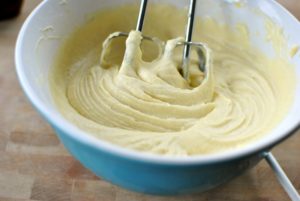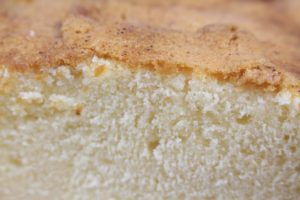Chemistry in the kitchen

Raw cake mixture
Cooking food is simple and easy for me plus everyone enjoys food cooked by somebody else. I have also rediscovered baking, just four or five basic ingredients and you create a cake. Incidentally I love raw cake mixture, but the cooked product is sooo much better. It was after a recent cake disaster that I thought I ought to find out why a cake rises? Quite simply its chemistry in the kitchen.
Bit of research
I can never see any bubbles of air when I put the cake mixture into the oven. The mixture has the consistency of wallpaper paste but something happens in a hot oven. As the raw cake mixture cooks it rises and transforms into something light and fluffy. So instead of finding more depressing facts about multiple sclerosis I thought I would find out why a cake rises.
Chemistry in the kitchen

Baked cake
When fat and sugar are mixed together little tiny bubbles of air are trapped. In my youth I used to do this by hand now I must use an electric mixer, thanks MS. The next ingredients are beaten egg followed by self raising flour. Pour this goo into a cake tin and pop it into a hot oven, As the tiny bubbles of air will expand and the egg white cooks around each bubble of air. As the temperature of the cake rises the egg white forms a wall around each bubble.
Meanwhile
At the same time the gluten in the flour will stretch and help to keep the shape of the cake. As the temperature rises the gluten loses its elasticity and the shape of the cake becomes fixed.
Resist that temptation
Don’t open the oven door and have a quick peek. I know its awfully tempting but the temperature in the oven will suddenly drop. Now the air making the bubbles will contract and the whole structure of the cake will collapse. Just wait until three quarters of the cooking time has passed.
Never thought about it
It is chemistry that goes on when baking a cake. Where do the bubbles come from and how do they keep their shape? This all sounds super scientific. I just follow the instructions in the recipe and hope for the best. What follows is chemistry in the kitchen.
I do experiment
One Sunday afternoon I was going to make a carrot cake and while assembling the ingredients I realised there was no carrot or banana in the house. Bad news, both are essential ingredients and the shops had shut. so I had to rummage around in the fridge. I found a couple of new potatoes and four pears so I used those instead, it was a winning combination.
Soft and slightly sweet
I enjoy cooking and baking. it’s something I can do despite the handicaps of multiple sclerosis but I must take my time and be organised. There are occasions when I think it’s going to be a mission too far but that desire to eat something I have made myself always wins the day. It really is chemistry in the kitchen.
Associated articles
 Call it advanced multiple sclerosis
Call it advanced multiple sclerosis
.
.
.
.
.
 VELA Salsa sit-stand chair
VELA Salsa sit-stand chair
.
.
.
.
.
February 2020



Nice subject! I too have MS and love cake. I make some cakes in the microwave too, which is safer for me. Small point: gluten loses ELASTICITY, not electricity…
Hello Helen,
I have always loved cooking and baking, its something I can do despite MS but just recently the fatigue has been kicking in and loss of motor control makes can make things a bit tricky. Just have to take my time.
Thanks for pointing out the typo, now corrected
Yup. Math, physics and chemistry equal cooking and baking! You got this!
Hi,
Well I just follow the recipe, tend to use Delia Smith or Mary Berry as their recipes are tried and tested.